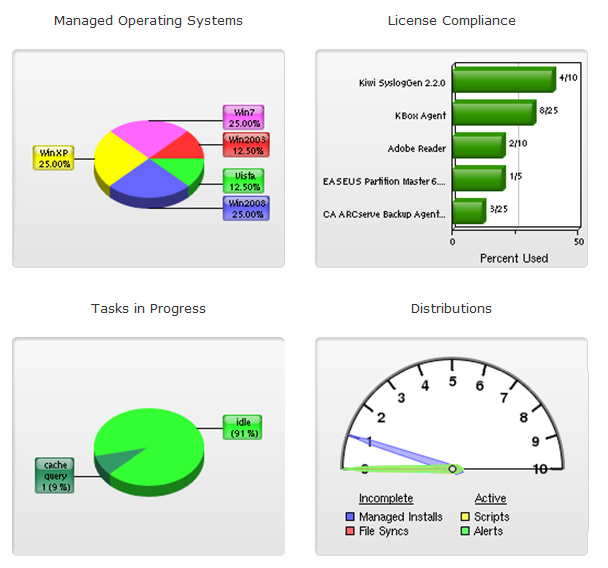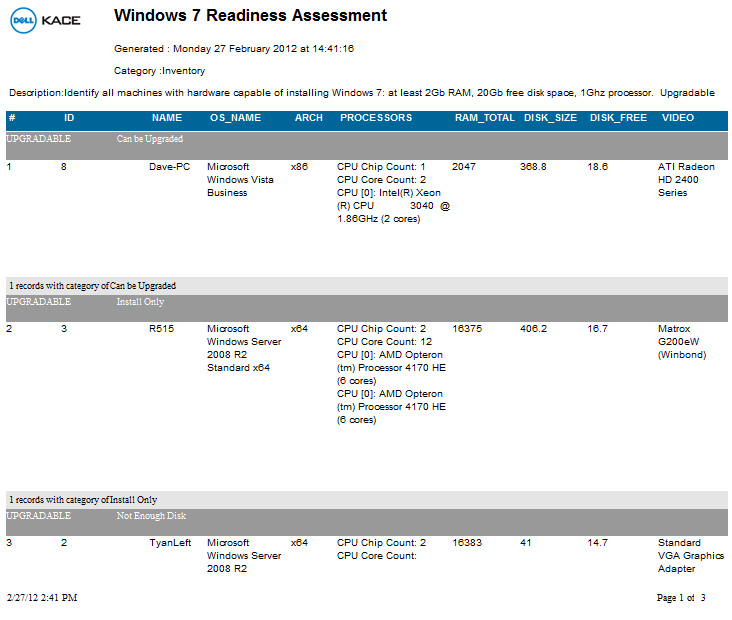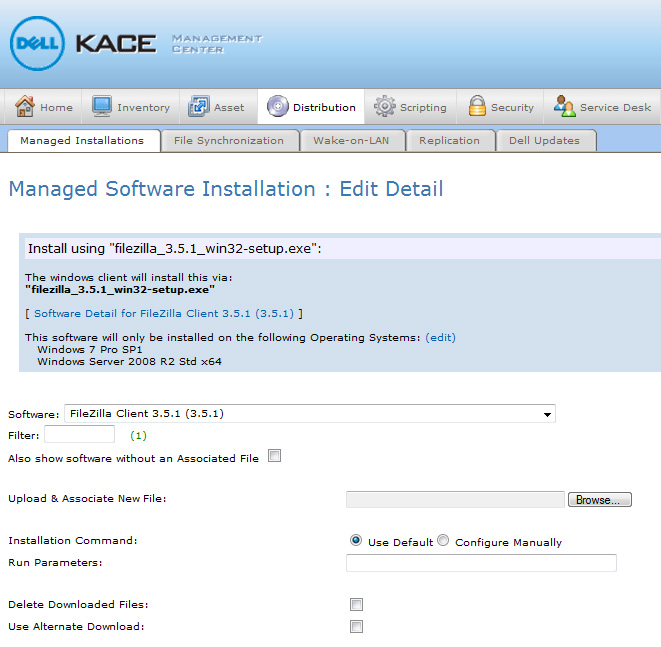Dell Kace K1000 system management appliance review
Dell’s Kace appliances aim to be a more sensible alternative to systems management heavyweights such as Altiris and LANDesk. The K1000 looks a lot better value and in this review, Dave Mitchell finds out if it has the features to match.
Dell’s Kace K1000 systems management appliance provides a good range features and is comparatively easy to deploy. It’s also good value, as a lot of functions are included in the price — just bear in mind that Linux systems are poorly supported, the agentless inventory is of little use and the Kontainer application virtualisation feature is no longer available

Licences can be monitored from the Kace 1000 interface's Summary page, which shows a colour-coded chart for at-a-glance expiry information. Charts for the spread of OSes, online systems and security alerts are also shown here, but it's about time Dell turned these into widgets so that the view can be customised.

A summary dashboard shows the status of agents and license metering, but the layout can't be customised.
Dell also provides a heap of predefined reports and custom ones can also be created. The latter is wizard driven, where a topic is selected from a wide range and rules added accordingly. SQL query statements can also be used to further interrogate the appliance for more detailed reports.

Dell provides plenty of predefined reporting tools for interrogating the inventory.
The Service Desk feature adds a lot of value to the Kace 1000, as it allows users to submit trouble tickets via email or the Service Centre web portal.
Administrators can view all tickets, see their status, assign them to users and change their priorities. Once a user has raised a support ticket, it can then be assigned to specific support staff or groups and automatic escalation rules can be applied.
One feature conspicuous by its absence is Kace's Kontainers, which presented virtual applications to clients that could be run safely in an isolated environment. Dell told us that Kontainers are no longer supported for new customers and that it plans to replace them with a third party solution.
Dell partners with Lumension for patch management and employs its PatchLink service. SLAs exist between the two companies to ensure that Lumension tests and verifies all patches before they are pushed to the appliance.
Patching is only fully supported on Windows and OS X, and patches can be downloaded to the appliance from Lumension at scheduled intervals. Critical patch application can be fully automated and a remote replication share can be used to store patches elsewhere, so systems don't have to keep going to the appliance for them.

Software packages can be uploaded to the appliance and distributed to selected systems at scheduled times.
We rate the K1000 appliance highly for ease of fuse, since it is a lot simpler to deploy than the bloatware from LANDesk and Altiris. Some functions, like license metering, take a while to get to grips with, but Dell's Smart Labels are a powerful feature and the appliance is good value.
Verdict
Dell’s Kace K1000 systems management appliance provides a good range features and is comparatively easy to deploy. It’s also good value, as a lot of functions are included in the price — just bear in mind that Linux systems are poorly supported, the agentless inventory is of little use and the Kontainer application virtualisation feature is no longer available
SPECIFICATIONS Chassis: 1U Dell PowerEdge R610 CPU: 2x 2.4GHz Xeon E5620 Memory: 6GB 1067MHz DDR3 Storage: 3x 250GB Dell SATA hot-swap hard disks RAID: Dell PERC 6/i Network: Gigabit Ethernet Management: Web browser Subscriptions: Annual maintenance/support: 20% of list price; Jumpstart training, £1,020 (all ex VAT)
Get the ITPro daily newsletter
Sign up today and you will receive a free copy of our Future Focus 2025 report - the leading guidance on AI, cybersecurity and other IT challenges as per 700+ senior executives
Dave is an IT consultant and freelance journalist specialising in hands-on reviews of computer networking products covering all market sectors from small businesses to enterprises. Founder of Binary Testing Ltd – the UK’s premier independent network testing laboratory - Dave has over 45 years of experience in the IT industry.
Dave has produced many thousands of in-depth business networking product reviews from his lab which have been reproduced globally. Writing for ITPro and its sister title, PC Pro, he covers all areas of business IT infrastructure, including servers, storage, network security, data protection, cloud, infrastructure and services.
-
 Cleo attack victim list grows as Hertz confirms customer data stolen – and security experts say it won't be the last
Cleo attack victim list grows as Hertz confirms customer data stolen – and security experts say it won't be the lastNews Hertz has confirmed it suffered a data breach as a result of the Cleo zero-day vulnerability in late 2024, with the car rental giant warning that customer data was stolen.
By Ross Kelly Published
-
 Women show more team spirit when it comes to cybersecurity, yet they're still missing out on opportunities
Women show more team spirit when it comes to cybersecurity, yet they're still missing out on opportunitiesNews While they're more likely to believe that responsibility should be shared, women are less likely to get the necessary training
By Emma Woollacott Published
-
 OpenAI wants developers using its new GPT-4.1 models – but how do they compare to Claude and Gemini on coding tasks?
OpenAI wants developers using its new GPT-4.1 models – but how do they compare to Claude and Gemini on coding tasks?News OpenAI says its GPT-4.1 model family offers sizable improvements for coding, but tests show competitors still outperform it in key areas.
By Ross Kelly Published